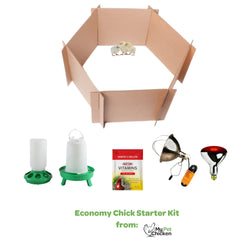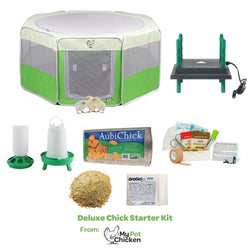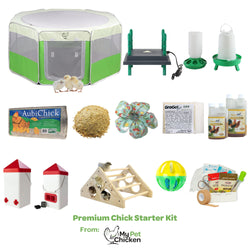Do I need to trim my chickens' nails? If so, how do I do it?
Back to blog
Long nails occasionally happen, and it is a good idea to trim them if they get too overgrown so your birds can walk without difficulty. In most cases they wear down on their own, but that is not always the case--sometimes trimming will help. Chickens kept in cages often have foot and nail problems, but sometimes even if your birds have solid ground and the run of the yard, their nails may grow too long if they are often broody and don't walk around enough to wear them down.
I have a silkie who gets long toenails, for instance. She never enjoys the trimming process. However, she is always much happier afterward. You can use toenail trimmers designed for dogs' nails, but you can also use some old toenail trimmers of your own that are ready to be relegated to the chickens' use. Your clippers simply need to be large enough to fit around your chickens' nails so you can accomplish the cuts.

When you trim, you will want to avoid cutting the vein in the nail, just like you would if you were trimming a dog's toenails. Some breeds have dark nails, and it can be hard to see the vein because of the color. If that's the case, you can try using a bright flashlight to stay away from the vein. Using a flashlight makes it a two person operation, but you can more easily see where to stop. You will want to stay a quarter inch or so away from the vein. Trim a very small amount of the nail off at a time--don't make a big cut all at once, or you are more likely to cut too far. If you pay attention, you can see if you are getting close to a vein because the color of the inside of the nail will change. If the color changes, you are too close--stop! Be very careful and don't push it. The nails don't have to be short, they just have to allow for the natural position of the foot. Also be sure to have some styptic powder or cornstarch on hand just in case you accidentally cause bleeding--you can use it to help the blood clot.
If you don't think you can manage trimming very well on your own--it is nervewracking, and there is a potential for trimming too far and hurting your chicken--you could contact a vet or even a dog groomer in your area who has more experience trimming nails.
Again, overgrown nails are not normally a problem in most flocks with access to the natural ground, but birds who are broody a lot may not be wearing their nails down at the pace needed for comfort. Lastly, if you are seeing excessive nail (or beak) growth frequently in an active bird with access to the natural ground, it can sometimes indicate liver issues, and you may want to have her checked by a veterinarian just to be safe.
I have a silkie who gets long toenails, for instance. She never enjoys the trimming process. However, she is always much happier afterward. You can use toenail trimmers designed for dogs' nails, but you can also use some old toenail trimmers of your own that are ready to be relegated to the chickens' use. Your clippers simply need to be large enough to fit around your chickens' nails so you can accomplish the cuts.

When you trim, you will want to avoid cutting the vein in the nail, just like you would if you were trimming a dog's toenails. Some breeds have dark nails, and it can be hard to see the vein because of the color. If that's the case, you can try using a bright flashlight to stay away from the vein. Using a flashlight makes it a two person operation, but you can more easily see where to stop. You will want to stay a quarter inch or so away from the vein. Trim a very small amount of the nail off at a time--don't make a big cut all at once, or you are more likely to cut too far. If you pay attention, you can see if you are getting close to a vein because the color of the inside of the nail will change. If the color changes, you are too close--stop! Be very careful and don't push it. The nails don't have to be short, they just have to allow for the natural position of the foot. Also be sure to have some styptic powder or cornstarch on hand just in case you accidentally cause bleeding--you can use it to help the blood clot.
If you don't think you can manage trimming very well on your own--it is nervewracking, and there is a potential for trimming too far and hurting your chicken--you could contact a vet or even a dog groomer in your area who has more experience trimming nails.
Again, overgrown nails are not normally a problem in most flocks with access to the natural ground, but birds who are broody a lot may not be wearing their nails down at the pace needed for comfort. Lastly, if you are seeing excessive nail (or beak) growth frequently in an active bird with access to the natural ground, it can sometimes indicate liver issues, and you may want to have her checked by a veterinarian just to be safe.



